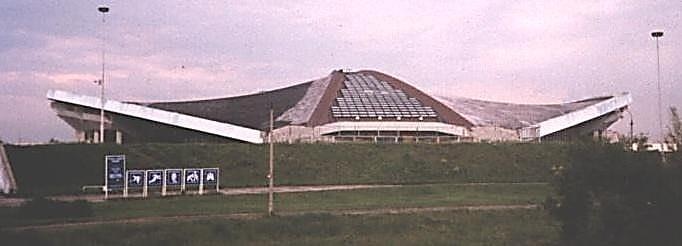Nov 13 2017
RUDN University professor collated disparate information about metal membrane suspended roofs that would facilitate designing buildings with large spans. These structures are used in the construction of airports, sports complexes, and a few other buildings. An op-ed article was reported in Thin-Walled Structures.
 This is the cycle track 'Krylatskoye' -- sports facility in Moscow, in the Krylatskoye district. (CREDIT - Sergey Krivoshapko)
This is the cycle track 'Krylatskoye' -- sports facility in Moscow, in the Krylatskoye district. (CREDIT - Sergey Krivoshapko)
Metal membranes are used much less often than other types of suspended roofs (among which one can distinguish awning or mesh metal structures, sheaths of glued wood). It is interesting that Russia has an unconditional priority in this type of constructions: they were first used abroad only 35 years later in the US, when they were developed by architect Vladimir Shukhov for 4 pavilions at the All-Russia industrial and art exhibition in Nizhny Novgorod.
Sergey Krivoshapko, Head of the Department of Strength of Materials and Structures of RUDN University
Metal membrane suspended roofs are spatial constructions of thin metal sheet, which is just a few millimeters thick, with a stiff support contour. They can be compared with a soap pellicle created after immersion of a wire ring into a diluted dishwashing liquid. Similar to a bubble, which is blown out of the contour, a metal membrane can have varied curvatures.
In fact, the design’s shape, more precisely, of its middle part, is formed by the geometry of the frame to which it is mounted and the location of weighting agents. Owing to them, it is possible to form a membrane in the shape of a cone, paraboloid, or sphere. Spans with metal membrane roofing can extend to hundreds of square meters. For instance, the universal stadium at Mira Avenue measuring 224×183 m, which was the largest building of the 1980 Olympics, is roofed by a 5 mm thick sagging membrane. The structure only looks like it is fragile: the technology involves intricate engineering calculations that keep in mind metal used for the construction, the climate, as well as load created both by the membrane’s weight itself and by falling snow. From a technical standpoint, the benefit of metal membranes is that they allow considerable reduction of the weight of the structure, material consumption (for steel up to 70%), and its cost (up to 60%). Furthermore, the structure itself suggests combination of bearing and enclosing functions in a single one material.
Design features of metal membrane suspended roofs determine their cost-effectiveness. Although nowadays almost all the problematic issues concerning the design, manufacturing, installation and operation of metal membranes are theoretically solved, few design bureaus and organizations are ready to take up work. The study of the preconditions for the appearance of functional solutions in construction, the history of development and the improvement of construction technologies will allow us to summarize the experiences accumulated over decades and issue a fundamentally new solution. Otherwise, architects and engineers will have to replicate what has already been achieved in construction and architecture.
Sergey Krivoshapko, Head of the Department of Strength of Materials and Structures of RUDN University